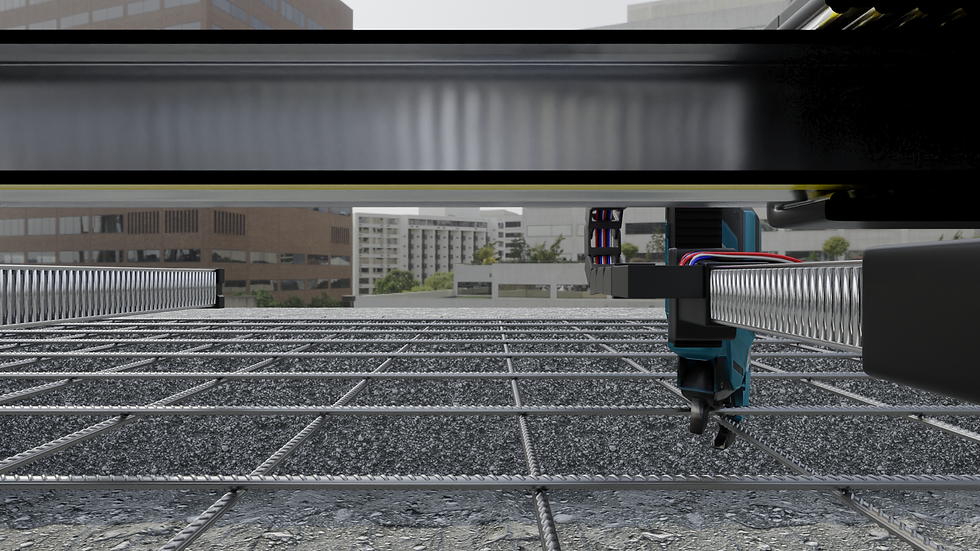Reinforcement Automation Redefined With the TSpider Construction Robot
- TSpider

- Jul 15
- 3 min read

Automation in construction has long focused on large-scale machinery and high-tech design tools, but one of the most labor-intensive tasks on any site still depends heavily on manual labor: rebar tying. It's slow, repetitive, and physically taxing. With large reinforcement areas requiring thousands of ties, the process becomes a bottleneck for speed, quality, and safety.
The TSpider robot redefines reinforcement work by automating rebar tying in a way that’s practical, intelligent, and adaptable. Designed to operate on both horizontal and vertical surfaces, it applies strong, consistent ties at every intersection, eliminating the need for manual effort and significantly reducing labor costs.
This next-generation construction robot is transforming how job sites operate by bringing automation directly to the ground, where it matters most.
Replacing Manual Tying With Multi-Point Robotic Precision
Each time TSpider moves forward, it performs four simultaneous treads through its four-legged mechanism. These mechanical legs not only secure the robot onto the rebar grid but also deliver accurate, stable, and repeatable ties in one fluid motion. This creates a faster rhythm of work without sacrificing quality.
Unlike single-head rebar tying guns or semi-automated handheld tools, TSpider offers a fully autonomous solution. Its self-balancing system ensures that ties are placed evenly without interruption or human guidance. This efficiency can translate into thousands of ties per day, with no decline in performance due to fatigue.
By removing the physical demands of the job, TSpider also protects workers from common injuries associated with bending, kneeling, and repetitive motion. The robot doesn’t just speed up reinforcement — it modernizes the role of labor in the process.
From Flat Surfaces to Vertical Rebar Walls Without Downtime
Where most tying tools stop at flat ground, TSpider keeps going. Its mechanical design and adhesive grip allow it to operate securely on vertical rebar assemblies — such as wall sections, columns, or infrastructure supports — without losing stability. This vertical capability expands the range of reinforcement areas the robot can cover.
The robot automatically scans and adapts to its environment using onboard AI and a 360° camera system. It can track its position across irregular intersections, adjust its route, and tie every node it encounters — even in challenging geometries or tight grid layouts.
Because it’s weather-resistant and doesn't rely on fixed power supplies, TSpider remains fully functional across a variety of environments. Whether operating outdoors on a bridge under construction or inside a foundation pit, it delivers reliable tying performance wherever it’s deployed.
Integration Ready and Built for Canadian Construction Demands
TSpider is designed with real-world adaptability in mind. Construction environments are rarely uniform, especially in regions like Canada, where projects often face extreme weather, seasonal transitions, and uneven ground conditions. TSpider’s rugged build, weather-resistant housing, and modular component system allow it to operate reliably year-round, without compromising performance.
Assembly is straightforward and fast. Workers don’t need extensive training to deploy or transport the robot. Its intuitive design includes a protective case, swappable cartridges, and universal battery compatibility — so it fits into a wide range of project workflows. Whether integrated into daily operations or reserved for large-scale concrete reinforcement jobs, TSpider delivers measurable productivity gains without disruption.
By choosing TSpider, construction firms can modernize without overhauling existing systems. It complements current tools and teams, scaling up operations in a way that’s efficient, affordable, and future-ready.
TSpider as a Strategic Asset for Modern Construction Companies
TSpider represents a turning point in reinforcement automation. It doesn’t replace crews — it elevates them. By handling one of the most physically demanding and repetitive tasks on a job site, the robot reduces strain, improves consistency, and accelerates timelines without additional supervision.
From bridges to multi-level buildings, TSpider adapts to any surface and delivers uniform results from the first tie to the last. With AI-powered navigation, a smart multi-leg tying system, and real-world durability, it offers construction companies a tool that turns a slow process into a strategic advantage.
In an industry where time, safety, and quality determine success, TSpider gives builders a head start — and keeps them ahead.




댓글